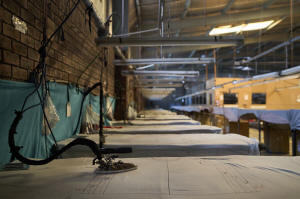US-imposed tariffs spelled disaster for this factory that exported
clothes to American stores
[July 31, 2025] By
RENATA BRITO
MASERU, Lesotho (AP) — The deafening roar of hundreds of sewing machines
has gone silent. Spools of thread in every color are covered in dust.
The warehouse is dark and empty.
In the tiny African nation of Lesotho, clothing manufacturer Tzicc's
business has dried up in the face of tariffs imposed by U.S. President
Donald Trump's administration. A few months ago, work was steady. The
factory's 1,300 employees have made and exported sportswear to American
stores, including JCPenney, Walmart and Costco.
But when Trump announced sweeping new tariffs on nearly all U.S. trading
partners in April, Lesotho found itself topping the list, with a rate of
50% — higher even than that of China, where the economy is 8,000 times
larger. Officials here and economic experts said they were baffled.
Since then, Trump backed off — temporarily. During a monthslong pause
for trade talks, the U.S. has charged a baseline 10% tariff and
announced new rates for dozens of countries starting Friday. Lesotho’s
rate will be set at Trump’s whim, with aides suggesting that tariffs
charged on goods from smaller African countries could top 10%.
Many nations have received letters laying out a new tariff. With the
pause set to expire Friday, Lesotho officials say they've not received
one and they find themselves among the countries where Trump says
officials simply don’t have time for one-on-one negotiations. Leaders —
and the 12,000 people employed by garment factories exporting to the
U.S. market — are still waiting.

The damage has already rippled through Lesotho’s economy, where textile
manufacturing comprises the largest private industry with more than
30,000 workers in 2024.
For Tzicc and its customers, the threat and apparent singling out of
Lesotho were enough. Management decided to rush to deliver preexisting
orders before tariffs resumed. But American buyers stopped placing new
orders. With no work left, virtually all the factory's employees were
sent home — potentially permanently.
“Well, unfortunately, we finished,” factory compliance manager Rahila
Omar said, pointing out the irony of the strategy as she walked among
rows of silenced and covered machines. “That is why now we don't have
any work.”
Omar is one of a handful of employees left in the eerily quiet factory.
A few remain in the accounting department; others empty leftover stock
to a warehouse elsewhere.
Officials and workers fear this may be a sign of what's to come for
other factories in Lesotho, where poverty is widespread among the
population of 2 million and most textile workers single-handedly support
their families.
Lesotho's tiny economy was threatened with giant tariffs
In March, a month before slapping Lesotho with the 50% tariff, Trump
described it as a place “nobody has ever heard of," struggling to
pronounce the nation's name in a speech criticizing U.S. foreign aid.
It's true Lesotho is a “very minuscule economy," as its own trade
minister, Mokhethi Shelile, described it.
But its relationship with Washington dates back decades. The U.S. was
the first country to open an embassy in the capital, Maseru, after
Lesotho declared independence from the United Kingdom in 1966. The
military received U.S. training, and hundreds of millions in U.S. funds
were sent to Lesotho to fight the HIV/AIDS epidemic via the now
defunctUSAID office and the PEPFAR program.
As textiles grew to become Lesotho's main export, some 75% of its
product went to the U.S. Lesotho became known as Africa's denim capital.
If an American purchased jeans from a U.S. brand such as Wrangler or
Levi's, they may have been “Made in Lesotho,” as tags still note.
In 2000, the U.S. signed the African Growth and Opportunity Act,
allowing Lesotho and other African nations to export goods to the U.S.
duty free.
Shelile said he was in the process of negotiating AGOA’s September
renewal when he was awakened in the middle of the night by texts from
aides bearing news of the 50% U.S. tariffs.
“No, this cannot be real,” Shelile remembers thinking. “What did we do
to deserve this?”
According to the Trump administration, Lesotho charges a 99% tariff on
U.S. goods. The government here said it doesn’t know how the U.S.
calculated that.
[to top of second column] |

An industrial iron lies on a work bench inside the empty Tzicc
clothing factory following the threat of U.S.-imposed tariffs in
Maseru, Lesotho, Tuesday, July 22, 2025. (AP Photo/Bram Janssen)

In theory, the tariff decision was based on trade deficit: Lesotho’s
exports to the U.S. were around $240 million last year — mainly clothing
and diamonds — and imports from the U.S. were only $2.8 million. But in
practice, the math is more complicated than that. And in reality,
Lesotho simply cannot afford to import more U.S. products. Nearly half
the population lives below the poverty line.
“The trade deficit that exists between Lesotho and the U.S. is a natural
trade deficit that can happen when you have these types of disparities
between two economies," Shelile said. "It cannot be breached and
certainly cannot be breached by imposing tariffs.”
Lesotho declared a state of emergency over unemployment
Last year, Lesotho's overall unemployment rate was about 30%, national
data shows. For those 35 and younger, it was nearly 50%.
The threat of tariffs has exacerbated the national unemployment
troubles, prompting the government to declare a state of disaster this
month.
“No matter how we slice it, we’ve already had a lot of losses," Shelile
said. "People have lost quite a lot money. And to claw back and come
back to where we were before this is going to take time.”
Most of the 12,000 people hired by Lesotho's 11 factories exporting to
the U.S. are women with children to feed and school fees to pay.
Of those, 9,000 jobs are directly in the line of fire and an additional
40,000 will suffer indirectly from the U.S.-imposed tariffs, Shelile
said.
“We’re talking people in real estate that are leasing some rooms,” he
said. “We’re talking people in transport, whether it’s long-distance
haulage to the port, or it is a taxi driver taking people to work in the
morning. They are going be affected.”
Mapontso Mathunya used to work on Tzicc’s cutting room floor and is now
unemployed. Her husband also is out of a steady job. With two young
children, Mathunya was the family's breadwinner. She now tries to sell
snacks and cigarettes on the street but finds it a daily struggle to
bring home even a few cents.
“Our financial burden has been heavy," she said. “Things are bad.”

The future of this factory and others remains in limbo
The future of the Tzicc factory depends on what happens Friday,
compliance manager Omar said.
Owned by a Taiwanese national, the factory has been open since mid-1999.
In a peak month, it made up to 1.5 million pieces of clothing for
JCPenney.
Key U.S. customers for Tzicc — JCPenney, Walmart and Costco — did not
reply to AP to comment.
Pivoting to the neighboring South African market, one of the solutions
proposed by the trade minister and industry consultants, wouldn’t be
enough to even cover the employees’ payroll, Omar said.
And even if American buyers return, it’s unlikely the factory could
rehire all its 1,300 workers, she added.
Today, just a few blocks away, former employees try their luck looking
for work at other factories that are still operating. Most are turned
away.
“Life is difficult,” former worker Mathunya said. “There is nothing,
nothing at all. People don’t have money.”
______
Pascalinah Kabi in Maseru, Josh Boak in Washington and Anne D’Innocenzio
in New York contributed.
All contents © copyright 2025 Associated Press. All rights reserved |